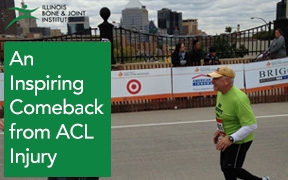This article is part of the Ultimate Guide to Knee Pain Relief.
As many components make up the knee, your knee can be susceptible to a wide range of injuries. In fact, orthopedic doctors probably see more patients for knee injuries than any other type of orthopedic problem. Here are some of the most common knee injuries, along with their causes, symptoms and treatments.
Fractures
Knee fractures range from minor cracks to multiple breaks. The patella, which is the bone surrounding the knee, is the one that’s broken the most.
• Causes—often, knee fractures are the result of vehicle crashes, falling from heights or other types of trauma.
• Symptoms—swelling, severe pain and tenderness when pressing the kneecap are some of the main signs.
• Treatments—surgery may be needed when a bone is pulled apart. However, if your bone is in a good position, all that may be required is using a brace, applying ice packs, taking NSAIDs (non-steroidal anti-inflammatory medicines), rehabilitation exercises and watchfully waiting for any changes. Of course, consult with your physician for any knee injuries and follow her directions on rehabilitation.
Meniscal Tears
These are tears in the menisci or cartilages that lie between the tibia and femur bones in your lower leg.
• Causes—most meniscal tears are the result of knee twisting, pivoting or other movements that occur when playing sports. They can also be caused by aging or arthritis. Sometimes, just standing up from a chair can cause a meniscal tear if your menisci have become weak.
• Symptoms—common symptoms include inflammation, pain and stiffness. Another red flag is difficulty in fully extending your knee.
• Treatments—applying ice, getting rest and using medications are some of the non-invasive treatments for relieving pain and allowing the injury to heal. On the other hand, surgery may be needed in more severe cases.
Bursa Inflammation
Also called prepatellar bursitis, this an injury involving the bursa, which is the space between the kneecap and skin.
• Causes—the main cause is frequently rubbing or constant pressure on knees. This can be caused from a fall directly on the knee, or via crawling or kneeling. When this occurs, the bursa becomes filled with fluid and swollen. It’s a common injury among roofers and carpet installers.
• Symptoms—the two main symptoms are limited range of the knee and inflammation.
• Treatment—taking anti-inflammatory medicines and padding your knee are some of the most common treatments for prepatellar bursitis.
Knee Tendinitis
This injury occurs below the kneecap. It can affect either the front or back of your knee.
• Causes—usually the result of jumping, so it’s also called “jumper’s knee.”
• Symptoms—the most common sign is having pain with movement. The pain can be especially intense when you run, walk fast or even go up and down stairs. Swelling may also occur.
• Treatments—knee tendinitis is typically treated by using ice packs, immobilization, taking anti-inflammatory medicines and resting.
IBJI has over 20 locations in the Chicagoland area. If you are suffering from any type of knee pain, contact a physician at IBJI for expert care and treatment.
*This content is for information only and is not intended to replace the diagnosis, treatment, or medical advice from your treating healthcare professionals. The content does not provide medical advice, does not constitute the practice of medicine or other healthcare professional services, and does not create a doctor-patient relationship. You should not rely on this information as a substitute, nor does it replace professional medical advice, diagnosis, or treatment. If you have concerns or questions, seek the advice of your healthcare professionals. If you think you may have a medical emergency, call your doctor or 911 immediately. Do not rely on electronic communications or communicate through this website for immediate, urgent medical needs. This website is not designed to facilitate medical emergencies. The use of the information is at the reader’s own risk. The links are provided for information and convenience only. We cannot accept responsibility for the sites linked or the information found here. A link does not imply an endorsement of a site.





